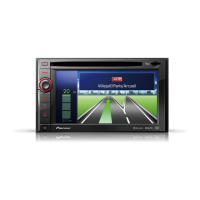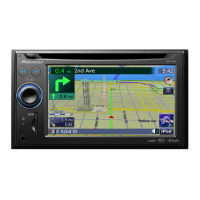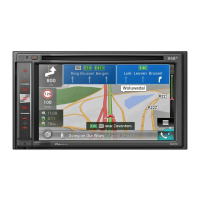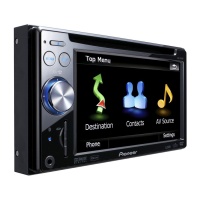
Do you have a question about the Pioneer AVIC-F9220BT and is the answer not in the manual?
| Geocaching (GPS stash hunt) | Yes |
|---|---|
| Marine (chartplotters, sounders) | No |
| Map view options | 2D/3D |
| GPS receiver | L1, C/Acode GPS, SPS |
| Power requirements | 14.4 V DC |
| Form factor | Plug-in |
| Product color | Black |
| Channels quantity | 30 channels |
| Display diagonal | 6.1 \ |
| Native aspect ratio | 16:9 |
| Compatible memory cards | microSDHC |
| Bluetooth version | 2.0+EDR |
| USB 2.0 ports quantity | 1 |
| Audio formats supported | AAC, MP3, WAV, WMA |
| Image formats supported | JPG |
| Storage temperature (T-T) | -20 - 80 °C |
| Operating temperature (T-T) | -10 - 60 °C |
| Depth | 155 mm |
|---|---|
| Width | 178 mm |
| Height | 100 mm |
| Weight | 2250 g |
Overview of the manual's structure and how to use it.
Explains symbols, formatting, and terminology used throughout the manual.
Discusses data retention and erasure when the vehicle battery is disconnected.
Identifies and explains the main parts and buttons of the navigation system.
Provides instructions for handling discs in the unit's drive.
Instructions for connecting and managing iPod devices.
Illustrates how to navigate between different menu screens and functions.
Details the functions accessible from each main menu.
Explains the various elements displayed on the map screen.
Covers adjusting map scale and orientation for better usability.
Allows selection between 2D, 3D, and Street View map displays.
Shows a graph comparing driving efficiency with past performance.
Outlines the general steps for setting a destination and calculating a route.
Details methods for finding locations using street, city, or postcode.
Guides on confirming a location and calculating the route.
Allows adjustment of route calculation preferences like avoiding tolls.
Explains how to add, delete, and sort waypoints on a route.
Covers adding frequently visited places for quick access.
Displays a list of all available traffic incidents.
System automatically finds a better route based on traffic conditions.
Introduces methods for pairing devices.
Details various methods for initiating calls.
How to answer or reject incoming calls.
Choosing between different audio/video inputs.
How to control radio functions via the screen.
How to save and retrieve favorite radio stations.
How to control AM radio functions via the touch screen.
How to control CD playback functions via the screen.
Steps to play music files from discs.
How to control DVD playback functions via the screen.
Allows resuming playback from a saved point.
Locates and plays specific moments within a DivX video.
Manages viewing restrictions for adult content.
Steps to begin playing music files from USB or SD cards.
Allows selection and playback of specific video files.
Steps to play video content from an iPod.
Plays playlists created with the MusicSphere PC application.
Steps to connect and use a Bluetooth audio device.
Displays video from connected AV input 1.
Displays video from connected AV input 2.
How to control external units via the screen.
Accesses navigation system settings.
Enters fuel data to estimate travel costs.
Accesses settings related to map display and appearance.
Accesses general system configuration options.
Adjusts volume levels for navigation prompts and phone calls.
Configures the system for rearview camera display.
Fine-tunes brightness, contrast, color, and dimmer settings.
Accesses audio settings like EQ, Loudness, and Staging.
How to activate the voice command system.
Guides on using voice commands for navigation and other functions.
Configures a password to protect the navigation system.
Resets the system to its original state.
Provides solutions for common navigation system problems.
Lists error messages and corrective actions.
Explains how GPS and dead reckoning work together for positioning.
Tables detailing compatibility for various file types and media.
Technical details and features of the navigation system.











